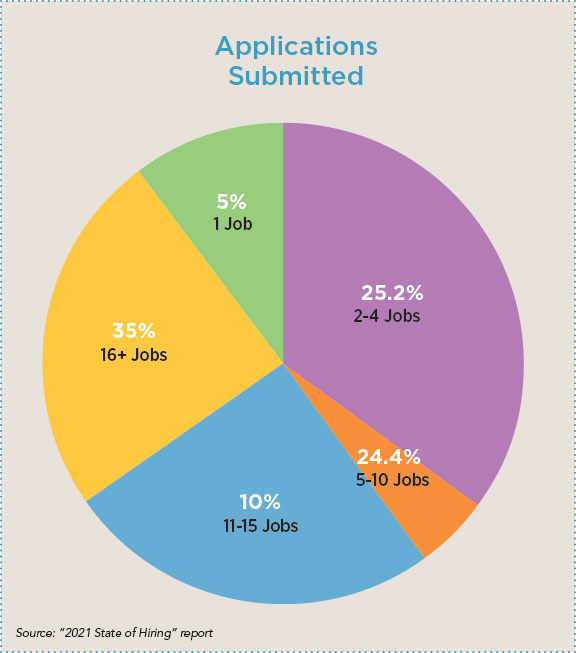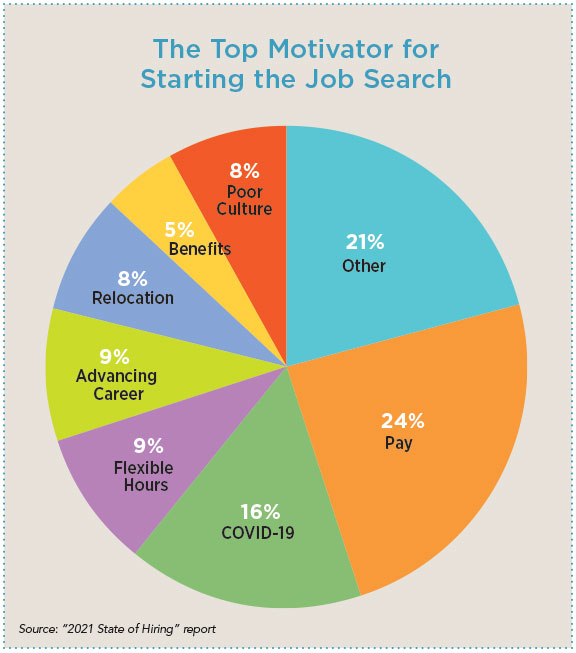Staffing has remained a challenge for post-acute and long term care organizations since the late 2000s as baby boomers neared retirement age. This demographic shift resulted in an influx of senior care services and will only continue to grow and put more strain on the health care system.
According to the U.S. Census Bureau, in 2015 there were an estimated 47.8 million Americans over age 65. By 2050, 87.9 million Americans will be over the age of 65, an increase of nearly 84 percent. AARP reported that on average, 52 percent of people who turn 65 will require some type of long term care services in their lifetimes.
The pandemic has exacerbated these workforce challenges and put a major spotlight on an issue that post-acute and senior care providers have been dealing with for years. While there is no single solution to solve the current health care workforce shortages, facilities and communities can take action to improve their recruitment, hiring, and retention rates moving forward.
It starts with understanding the motivations of today’s job seekers. Hireology’s “2021 State of Hiring” survey recently surveyed thousands of health care job applicants to develop a profile of today’s health care job seeker. This article highlights some of Hireology’s findings and how health care employers can stay on top of today’s competitive labor market.
Applicant’s Experience Matters
Today’s job applicants have more choices than ever, which means employers need to go above and beyond to exceed the expectations of the applicants they’re trying to court.
The applicant experience begins with the employment application. Research conducted by CareerBuilder1 has shown that 60 percent of applicants fail to complete an application due to length or complexity. Applicants know their time is valuable and have plenty of other opportunities available.
It’s the responsibility of the hiring manager to gradually collect the necessary applicant information throughout the hiring process rather than expecting an applicant to fill out lengthy applications.
 Another important facet is the medium of how applicants are conducting their job search. The survey found that over 57 percent of health care applicants utilized their smartphone (Apple iPhone or Android phone) to aid in their job search, indicating that mobile devices are the preferred medium for managing their job search.
Another important facet is the medium of how applicants are conducting their job search. The survey found that over 57 percent of health care applicants utilized their smartphone (Apple iPhone or Android phone) to aid in their job search, indicating that mobile devices are the preferred medium for managing their job search.
Additionally, 35 percent of applicants said they would feel negatively about not having the option to apply via mobile device. Therefore, career sites and online applications that aren’t mobile-friendly are inadvertently turning applicants away.
With job seekers conducting a majority of their job searches on their smartphones, text messaging has become the medium of choice when engaging with applicants. Mobilesquared reported that over 95 percent of all text messages are read within three minutes of being sent. In today’s tight labor market, keeping candidates engaged and reducing hiring velocity (the time it takes to make a new hire) will mean the difference between landing top candidates and settling for what’s left over.
Pre-pandemic, 55 percent of health care applicants were hired within two weeks of starting their job search. That number jumped to over 60 percent in October 2020, based on Hireology survey data from its “2020 Applicant Experience” and “2021 State of Hiring” reports. However, employers shouldn’t sacrifice quality and verification measures for the sake of making quick hires, but should instead focus on areas of their hiring process that affect efficiency and hiring velocity.
The “2021 State of Hiring” report found that hiring velocity is important because over 69 percent of applicants surveyed applied to five or more jobs during their job search, indicating that their desire to get to work quickly was elevated.
If a company’s hiring process takes too long, that applicant is likely already in conversations with other organizations.
Employment Enhanced by Benefits
Seventy-one percent of respondents in the “2021 State of Hiring” report indicated a neutral or positive perception about working in a health care position, however, 80 percent of health care hires responded that they would be open to working in a new industry if the right opportunity came along. The latter ties into the negative numbers associated with employee burnout and turnover in the health care industry.
Keeping quality candidates around can be done by focusing on offering attractive employment benefits. Twenty-four percent of respondents indicated that seeking better pay was the main reason for beginning their job search.
While increased pay may be an unsurprising top motivator, the survey results were extremely positive, stipulating alternatives when increasing pay is either prohibitive or not possible. Flexible hours are very important, especially in the midst of the pandemic, because parents are dealing with new challenges at home such as school closures, taking care of elderly parents, or dealing with other pandemic-related problems.
Offering career advancement opportunities is another way that organizations can remain competitive when increasing pay is not an option. Creating opportunities for employees to participate in training or continuing education programs are also great ways to increase employee engagement and satisfaction scores.
LinkedIn’s “2018 Workforce Learning Report” revealed that 94 percent of employees would stay at a company longer if it invested in their career development, so to keep team members around, organizations should give them long-term advancement opportunities.
Maintaining a Good Employer Brand
In order to attract applicants, it takes a concerted effort to invest in an organization’s employment brand—especially when employers are trying to convince quality applicants to apply to their roles.
 An excellent employer brand will serve as an organization’s best recruitment tool to persuade job seekers that they are an employer of choice.
An excellent employer brand will serve as an organization’s best recruitment tool to persuade job seekers that they are an employer of choice.
An important first step in building up a strong employer brand starts with developing a meaningful career site. Organizations should strive to create a career site that excites visitors and provides the pertinent information that job seekers are looking for—including culture, list of open positions, employment benefits, mission and vision statements, employee testimonials, and any other information that differentiates that organization from the rest.
Job seekers are doing their research, utilizing resources like Glassdoor, to gather relevant employee reviews on companies that they are considering applying to. Prospective applicants will use that feedback to determine whether they apply or look elsewhere, regardless of the merit of those reviews.
According to a “2018 Reputation Management Study” by MRINetwork, 70 percent of job seekers wouldn’t accept an offer from an employer with a bad employer brand. Business owners need to take ownership and address any negative reviews head on without getting defensive or casting blame elsewhere.
The Ideal Candidate Experience
In today’s applicant economy—an occurrence in the job market where there are more open positions than there are available workers—employers need to intensify their approach to landing high-quality talent. Health care business owners and operators must review applicants quickly, engage with applicants through text messaging, and communicate how their hiring process works—including what to expect at each step—if they want to be successful.
Lastly, employers need to deliver on promises that were made in order to provide an excellent candidate experience. Follow-through is important to candidates, whether or not they’re offered a role. Sixty-three percent of health care respondents said they would feel negatively about a company that didn’t respond to their application, so even rejection emails are essential.
Understanding what applicants are looking for throughout the recruitment and hiring process can help health care organizations better attract and retain talent. It’s imperative to prioritize the things that matter to applicants so that post-acute and long term care organizations can remain competitive and hire great people quickly. n
Christopher Mercer is the director of healthcare market growth at Hireology, responsible for managing and growing Hireology’s healthcare strategic partnerships with a focus on post-acute and long term care facilities and communities. He can be reached at 858-822-9395 or cmercer@hireology.com.